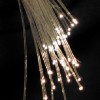Posts tagged 2009

Ribosome Discoveries Recognized in 2009 Nobel Prize in Chemistry
Oct 7th
The 2009 Nobel Prize in Chemistry will be shared between Venkatraman Ramakrishnan, Thomas A. Steitz and Ada E. Yonath for discovering how ribosomes function at the atomic level.
Ribosomes are molecular machines composed of RNA and protein that perform the critical function of translating messenger RNA (mRNA) into protein. In other words, they transform the genetic code from a static list of instructions into dynamic entities that constitute life. As the Nobel Foundation’s announcement eloquently put it, “they build and control life at the chemical level.”
In a tour-de-force of atomic chemistry, Ramakrishnan, Steitz, and Yonath used X-ray crystallography to locate each More >

2009 Nobel Prize in Physics goes to Kao, Smith and Boyle
Oct 6th
Telecommunications were the subject of the 2009 Nobel Prize in Physics. This year’s award will be split between two discoveries that have had a broad impact on contemporary life – fiber optics and charge-coupled device (CCD) technology.
Charles Kuen Kao will receive half the Prize for laying the foundations of the modern fiber optic industry. In 1966, he calculated how to transmit light signals over long distances using glass fibers. To that point, traditional materials had only been capable of transmitting signals over short distances (i.e. 50 feet). Kao’s discovery demonstrated how to send signals over many miles. Four years later, More >

Blackburn, Greider and Szostak share Nobel for Telomeres
Oct 5th
Nobel Prize week kicked-off today with the announcement of the Prize in Physiology or Medicine. As predicted on these pages, Elizabeth Blackburn, Carol Greider, and Jack Szostak shared the award for discovering telomeres and telomerase. This is particularly good news for Cold Spring Harbor Laboratory, which was home to Carol Greider when she made the pivotal discovery of isolating the RNA gene that encodes for the telomeric template.
Carol Greider isolated the Telomeric Gene while at Cold Spring Harbor Lab
What is a Telomere? A telomere is a region (or cap) of repetitive DNA at the end of every chromosome that basically More >
